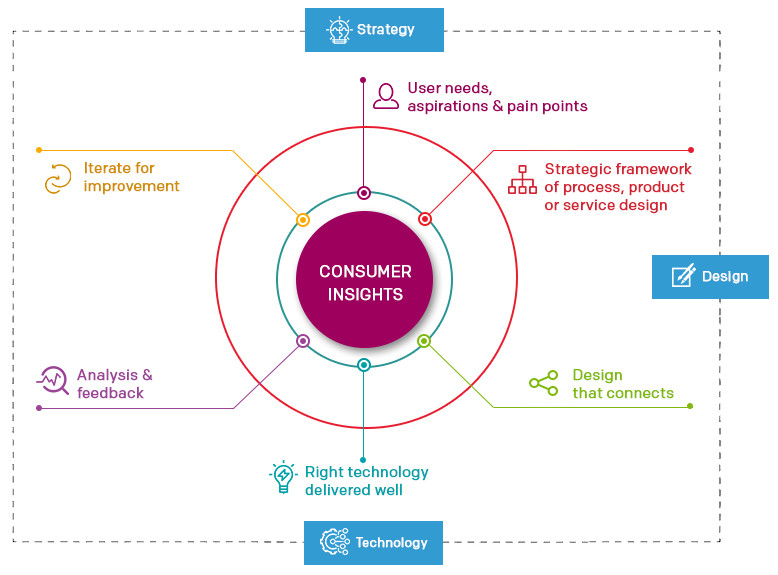We live in a digital world. Yet, brick & mortar is very much part of our lives. Given the hype around online & mobile app based sales one would think the offline retail has shut shop. But that’s from the truth. In the US, ecommerce now accounts for 14.3% of total retail sales. It is a significant jump from a 5% share just a decade ago, but consumers still flock to brick & mortar retail for their shopping needs. In 2018, Amazon was expected to contribute to 49% of the US e-commerce market and 5% of all retail spend.
Beyond retail, many other purchase or usage related experiences have gone digital. Brands of the gig economy, banking & payment services, games and many more have come to be judged by their digital experiences. Paradoxically, brick & mortar enterprises need to ‘go digital’ more than ever. A hotel’s guest experience may be driven by it’s service quality, courteous & efficient staff, culinary experience and creature comforts. But there is a digital component to the brand experience starting from its website, the booking engine, quality and efficiency of the backend software (including room booking, services management etc.) the consumer facing mobile app and more. Even in B2B enterprises, the scope for digital to play a role in delivering better experiences is huge. Of late, large enterprises have started relying on Enterprise Mobility Apps for faster communication and improved productivity.
In both B2B and B2C domains, product or service parity is the norm. It is every rare to find an enterprise or brand hold an unmatched edge over competition. In that context, customer experience becomes critical.

There can be elements of customer experience which are purely offline. For example, the way a customer is greeted and attended to at a retail store, the on-boarding experience of a new employee at in an enterprise and many more have significant human touches which cannot be matched or replaced by a digital experience.
A great digital experience, be it in the B2C or B2B context starts with placing the needs of the end user at the center. There is no substitute for understanding the needs, aspirations and pain points of the customer and converting them into actionable insights. While customer research and quantitative numbers maybe be available to everyone, what separates the leaders from the followers is the ability to convert information into insights. It is an ever evolving process as customer needs keep changing with the times. Who would have imagined ten years ago that today customers could hire someone to wait in line? Such services, products and features thereof arise out of universal insights, gained through observation and intuition. While consumer insights remain at the core, we at Robosoft foresee six critical steps.

Understanding user needs
My recent favorite example of a delightful user experience was when Uber introduced the Spotlight feature which can help drivers locate a passenger in crowded streets, especially at night. The in-app messaging service too is a boon not just for the user but for English-challenged drivers in many developing countries. Such features are a result of understanding the user’s evolving needs. So how can we best understand user needs? It certainly cannot happen sitting in conference rooms and going through presentations. There is no substitute for observing the customer first hand. Better still, put yourself in the customer’s shoes and live their lives. If the task at hand is to design a lunch box typically used by a mother sending her children off to school early in the morning, there is no substitute to experience how it feels first hand – even if it means role playing and ‘switching’ genders momentarily.
Creating a strategic design framework
Next up, create a strategic framework for your product, service or the business problem you are attempting to solve. Principles of Design Thinking should be put to use to create a road map. It is a folly to think design thinking comes into play only when a design in terms of ‘look & feel’ is involved. We believe that Design Thinking is about the incorporation and unification of digital technology into all areas of a business resulting in positive changes in how businesses operate and deliver value. This stage may involve, iterative, collaborative process including prototyping.
Crafting a design with emotion and empathy
Is functionality more important than aesthetics? For years, enterprises placed more importance on the former with little attention paid to the latter. Today’s consumer is demanding and doesn’t seek compromises. A digital experience has to be about getting the task done AND in a memorable, visually pleasing manner. In other words, the design has to make the consumer ‘feel’ or address an emotion in a manner that subliminally cues, ‘yes, we understand you’.
Executing the right technology to deliver a delightful experience
Should your brand or enterprise offer a voice related consumer experience? Is an augmented reality solution a necessity for your brand? These and other emerging tech related queries are common now – way beyond the ‘native app vs web app’ kind of question. The answer is strategic in nature and a combination of consumer understanding, technology trends and expertise in such new skills.
Embedding a feedback loop and analysing the reports
A big advantage in the digital world as compared to products of yesteryears is that today, almost every digital product can provide feedback. Whether it is a website, an internal app for employee engagement or a consumer facing app – it’s usage or lack of it can provide tonnes of information. The trick is in converting this information into actionable insights.
Perpetual iteration towards improvement
Physical products of yesterday, especially capital-intensive productions like automobiles would iterate on new versions after a few years. While that maybe still so, many products & services demand constant and frequent version improvements.
This cyclical process places the user at the centre and involves 3 key pillars: strategy, design and technology.
The X-factor in all these processes is of course, the quality of people. While their skill sets, attitude and service standards may vary, the 6-step process could be a handy guide in charting digital experiences for enterprises.





